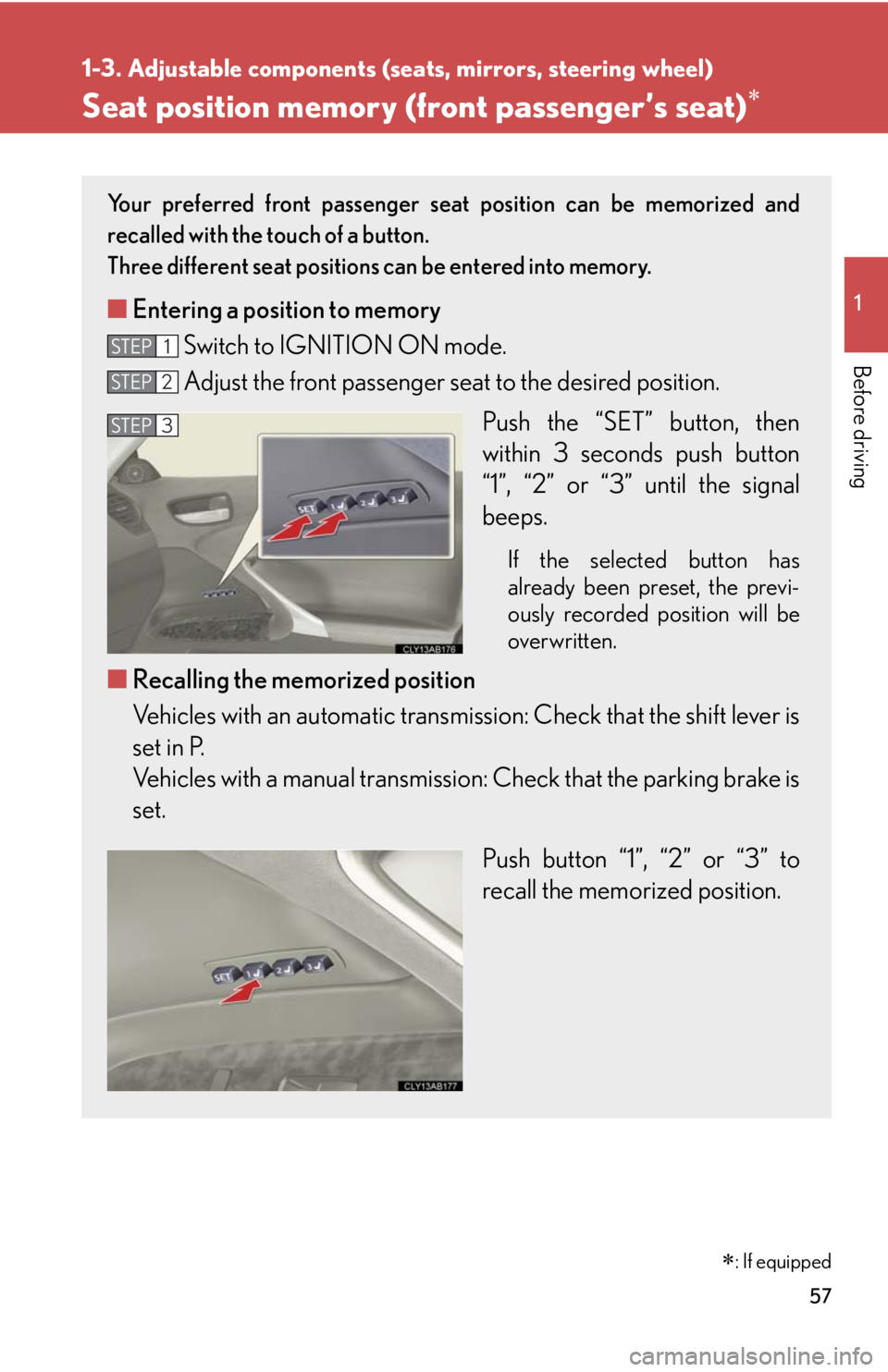brake Lexus IS250 2010 Using The Air Conditioning System And Defogger / LEXUS 2010 IS350 IS250 OWNERS MANUAL (OM53A23U)
[x] Cancel search | Manufacturer: LEXUS, Model Year: 2010, Model line: IS250, Model: Lexus IS250 2010Pages: 578, PDF Size: 16.25 MB
Page 3 of 578

1
2
3
4
5
6
7
3
2-1. Driving procedures
Driving the vehicle ........................ 124
Engine (ignition) switch .............. 134
Automatic transmission.............. 139
Manual transmission .................... 145
Turn signal lever ............................ 147
Parking brake ................................. 148
Horn.................................................... 150
2-2. Instrument cluster
Gauges and meters ....................... 151
Indicators and warning
lights................................................. 157
Multi-information display........... 160
2-3. Operating the lights and
windshield wipers
Headlight switch ............................ 165
Fog light switch .............................. 168
Windshield wipers and
washer............................................. 169
Headlight cleaner switch ........... 1742-4. Using other driving systems
Cruise control ................................ 175
Dynamic radar cruise
control............................................. 179
Intuitive parking assist ................. 190
Driving assist systems.................. 196
PCS
(Pre-Collision System) ........... 202
2-5. Driving information
Cargo and luggage ..................... 206
Vehicle load limits ........................ 209
Winter driving tips ........................ 210
Trailer towing .................................. 214
Dinghy towing
(vehicles with an automatic
transmission) ................................ 215
Dinghy towing
(vehicles with a manual
transmission) ................................ 216
2When driving
Page 13 of 578

13
C
Automatic transmission
Manual transmission
Seat heater switches
Seat heater/ventilator switches
P. 348
P. 351
Automatic transmission shift lever P. 139
Shift lock override button P. 503
Cigarette lighter
Ashtrays P. 346
P. 345
Manual transmission shift lever P. 145
Parking brake lever P. 148
Cigarette lighter
Ashtrays P. 346
P. 345
Seat heater switches
Seat heater/ventilator switches
P. 348
P. 351
: If equipped
Page 14 of 578

14
Pictorial indexInstrument panel
Headlight switch
Turn signal lever
Fog light switch P. 165
P. 147
P. 168
Shift paddle switches (automatic transmission) P. 142
Gauges and meters P. 151
Multi-information display P. 160
Windshield wiper and washer switch P. 169
Engine (ignition) switch P. 134
Trunk opener main switch P. 47
Glove box P. 333
Tilt and telescopic steering lock release lever P. 69
Tilt and telescopic steering control switch P. 70
Parking brake pedal (automatic transmission) P. 148
Audio remote control switches P. 277
Horn P. 150
Page 20 of 578

20
Installation of a mobile two-way radio system
As the installation of a mobile two-way radio system in your vehicle could affect
electronic systems such as the multiport fuel injection system/sequential multiport
fuel injection system, cruise control system, anti-lock brake system, SRS airbag sys-
tem and seat belt pretensioner system, be sure to check with your Lexus dealer for
precautionary measures or special instructions regarding installation.
Scrapping of your Lexus
The SRS airbag and seat belt pretensioner devices in your Lexus contain explosive
chemicals. If the vehicle is scrapped with the airbags and seat belt pretensioners left
as they are, this may cause an accident such as fire. Be sure to have the systems of
the SRS airbag and seat belt pretensioner removed and disposed of by a qualified
service shop or by your Lexus dealer before you scrap your vehicle.
Perchlorate Material
Special handling may apply, See www.dtsc.ca.gov/hazardouswaste/perchlorate.
Your vehicle has components that may contain perchlorate. These components may
include airbag, seat belt pretensioners, and wireless remote control batteries.
Page 53 of 578

53
1
1-3. Adjustable components (seats, mirrors, steering wheel)
Before driving
Driving position memory (driver’s seat)
Your preferred driving position (the position of the driver's seat, steering
wheel and outside rear view mirrors) can be memorized and recalled with
the touch of a button. It is also possible to set this function to activate auto-
matically when the doors are unlocked.
Three different driving positions can be entered into memory.
■Entering a position to memory
Switch to IGNITION ON mode.
Adjust the driver’s seat, steering wheel, and outside rear view
mirrors to the desired positions.
Push the “SET” button, then
within 3 seconds push button
“1”, “2” or “3” until the signal
beeps.
If the selected button has
already been preset, the previ-
ously recorded position will be
overwritten.
■Recalling the memorized position
Vehicles with an automatic transmission: Check that the shift lever is
set in P.
Vehicles with a manual transmission: Check that the parking brake is
set.
Switch to IGNITION ON mode.
STEP1
STEP2
STEP3
STEP1
�
: If equipped
Page 57 of 578

57
1
1-3. Adjustable components (seats, mirrors, steering wheel)
Before driving
Seat position memory (front passenger’s seat)
Your preferred front passenger seat position can be memorized and
recalled with the touch of a button.
Three different seat positions can be entered into memory.
■Entering a position to memory
Switch to IGNITION ON mode.
Adjust the front passenger seat to the desired position.
Push the “SET” button, then
within 3 seconds push button
“1”, “2” or “3” until the signal
beeps.
If the selected button has
already been preset, the previ-
ously recorded position will be
overwritten.
■Recalling the memorized position
Vehicles with an automatic transmission: Check that the shift lever is
set in P.
Vehicles with a manual transmission: Check that the parking brake is
set.
Push button “1”, “2” or “3” to
recall the memorized position.
STEP1
STEP2
STEP3
�
: If equipped
Page 123 of 578

When driving2
123
2-1. Driving procedures
Driving the vehicle.................. 124
Engine (ignition) switch ......... 134
Automatic transmission ........ 139
Manual transmission .............. 145
Turn signal lever ....................... 147
Parking brake ........................... 148
Horn ............................................ 150
2-2. Instrument cluster
Gauges and meters ................. 151
Indicators and warning
lights ......................................... 157
Multi-information display ..... 160
2-3. Operating the lights and
windshield wipers
Headlight switch...................... 165
Fog light switch ........................ 168
Windshield wipers and
washer ..................................... 169
Headlight cleaner switch....... 1742-4. Using other driving
systems
Cruise control........................... 175
Dynamic radar cruise
control ...................................... 179
Intuitive parking assist ........... 190
Driving assist systems ............ 196
PCS
(Pre-Collision System) ...... 202
2-5. Driving information
Cargo and luggage ............... 206
Vehicle load limits .................. 209
Winter driving tips .................. 210
Trailer towing ........................... 214
Dinghy towing
(vehicles with an
automatic transmission)..... 215
Dinghy towing
(vehicles with a
manual transmission) .......... 216
Page 124 of 578

124
2-1. Driving procedures
Driving the vehicle
The following procedures should be observed to ensure safe driving.
■Starting the engine (P. 134)
■Driving
Automatic transmission
With the brake pedal depressed, shift the shift lever to D.
(P. 1 3 9 )
Release the parking brake. (P. 1 4 8 )
Gradually release the brake pedal and gently depress the
accelerator pedal to accelerate the vehicle.
Manual transmission
While depressing the clutch pedal, shift the shift lever into 1.
(P. 145)
Release the parking brake. (P. 1 4 8 )
Gradually release the clutch pedal. At the same time, gently
depress the accelerator pedal to accelerate the vehicle.
■Stopping
Automatic transmission
With the shift lever in D, depress the brake pedal.
If necessary, set the parking brake.
When the vehicle is stopped for an extended period of time, shift the
shift lever to P or N. (
P. 1 3 9 )
Manual transmission
While depressing the clutch pedal, depress the brake pedal.
If necessary, set the parking brake.
When the vehicle is stopped for an extended period of time, shift the
shift lever into N. (
P. 1 4 5 )
STEP1
STEP2
STEP3
STEP1
STEP2
STEP3
STEP1
STEP2
STEP1
STEP2
Page 125 of 578

125
2-1. Driving procedures
2
When driving
Starting on a steep uphill
Automatic transmission
Firmly set the parking brake and shift the shift lever to D.
Gently depress the accelerator pedal.
Release the parking brake.
Manual transmission
With the parking brake firmly set and the clutch pedal fully
depressed, shift the shift lever into 1.
Lightly depress the accelerator pedal at the same time as gradu-
ally releasing the clutch pedal.
Release the parking brake.
■Parking the vehicle
Automatic transmission
With the shift lever in D, depress the brake pedal.
Set the parking brake. (P. 1 4 8 )
Shift the shift lever to P. (P. 1 3 9 )
Press the “ENGINE START STOP” switch to stop the engine.
Lock the door, making sure that you have the electronic key on
your person.
Manual transmission
While depressing the clutch pedal, depress the brake pedal.
Set the parking brake. (P. 1 4 8 )
Shift the shift lever into N. (P. 145)
Press the “ENGINE START STOP” switch to stop the engine.
Lock the door, making sure that you have the electronic key on
your person.
STEP1
STEP2
STEP3
STEP4
STEP5
STEP1
STEP2
STEP3
STEP4
STEP5
STEP1
STEP2
STEP3
STEP1
STEP2
STEP3
Page 126 of 578

126
2-1. Driving procedures
■Starting off on a hill (vehicles with an automatic transmission)
Hill-start assist control will operate. (P. 1 9 6 )
■Driving in the rain
●Drive carefully when it is raining, because visibility will be reduced, the windows
may become fogged-up, and the road will be slippery.
●Drive carefully when it starts to rain, because the road surface will be especially
slippery.
●Refrain from high speeds when driving on an expressway in the rain, because
there may be a layer of water between the tires and the road surface, preventing
the steering and brakes from operating properly.
■Breaking in your new Lexus
To extend the life of the vehicle, the following precautions are recommended to
observe:
●For the first 186 miles (300 km):
Avoid sudden stops.
●For the first 621 miles (1000 km):
• Do not drive at extremely high speeds.
• Avoid sudden acceleration.
• Do not drive continuously in the low gears.
• Do not drive at a constant speed for extended periods.
■Drum-in-disc type parking brake system
Your vehicle has a drum-in-disc type parking brake system. This type of brake sys-
tem needs bedding-down of the brake shoes periodically or whenever the parking
brake shoes and/or drum are replaced. Have your Lexus dealer perform the bed-
ding down.
■Operating your vehicle in a foreign country
Comply with the relevant vehicle registration laws and confirm the availability of the
correct fuel. (P. 5 2 2 )